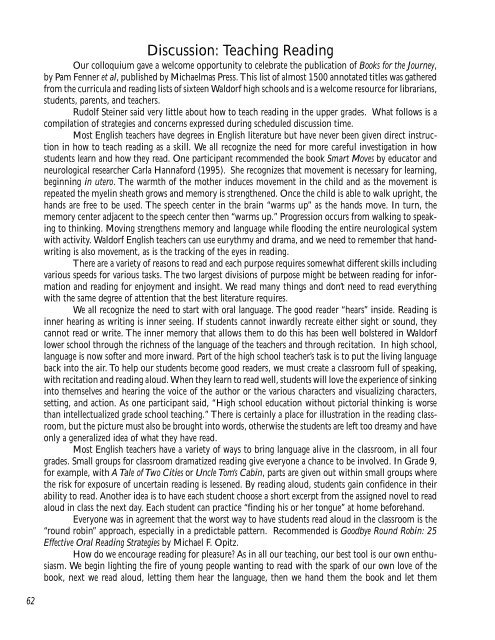Colloquium on English - Research Institute for Waldorf Education
Colloquium on English - Research Institute for Waldorf Education
Colloquium on English - Research Institute for Waldorf Education
You also want an ePaper? Increase the reach of your titles
YUMPU automatically turns print PDFs into web optimized ePapers that Google loves.
62<br />
Discussi<strong>on</strong>: Teaching Reading<br />
Our colloquium gave a welcome opportunity to celebrate the publicati<strong>on</strong> of Books <strong>for</strong> the Journey,<br />
by Pam Fenner et al, published by Michaelmas Press. This list of almost 1500 annotated titles was gathered<br />
from the curricula and reading lists of sixteen <strong>Waldorf</strong> high schools and is a welcome resource <strong>for</strong> librarians,<br />
students, parents, and teachers.<br />
Rudolf Steiner said very little about how to teach reading in the upper grades. What follows is a<br />
compilati<strong>on</strong> of strategies and c<strong>on</strong>cerns expressed during scheduled discussi<strong>on</strong> time.<br />
Most <strong>English</strong> teachers have degrees in <strong>English</strong> literature but have never been given direct instructi<strong>on</strong><br />
in how to teach reading as a skill. We all recognize the need <strong>for</strong> more careful investigati<strong>on</strong> in how<br />
students learn and how they read. One participant recommended the book Smart Moves by educator and<br />
neurological researcher Carla Hanna<strong>for</strong>d (1995). She recognizes that movement is necessary <strong>for</strong> learning,<br />
beginning in utero. The warmth of the mother induces movement in the child and as the movement is<br />
repeated the myelin sheath grows and memory is strengthened. Once the child is able to walk upright, the<br />
hands are free to be used. The speech center in the brain “warms up” as the hands move. In turn, the<br />
memory center adjacent to the speech center then “warms up.” Progressi<strong>on</strong> occurs from walking to speaking<br />
to thinking. Moving strengthens memory and language while flooding the entire neurological system<br />
with activity. <strong>Waldorf</strong> <strong>English</strong> teachers can use eurythmy and drama, and we need to remember that handwriting<br />
is also movement, as is the tracking of the eyes in reading.<br />
There are a variety of reas<strong>on</strong>s to read and each purpose requires somewhat different skills including<br />
various speeds <strong>for</strong> various tasks. The two largest divisi<strong>on</strong>s of purpose might be between reading <strong>for</strong> in<strong>for</strong>mati<strong>on</strong><br />
and reading <strong>for</strong> enjoyment and insight. We read many things and d<strong>on</strong>’t need to read everything<br />
with the same degree of attenti<strong>on</strong> that the best literature requires.<br />
We all recognize the need to start with oral language. The good reader “hears” inside. Reading is<br />
inner hearing as writing is inner seeing. If students cannot inwardly recreate either sight or sound, they<br />
cannot read or write. The inner memory that allows them to do this has been well bolstered in <strong>Waldorf</strong><br />
lower school through the richness of the language of the teachers and through recitati<strong>on</strong>. In high school,<br />
language is now softer and more inward. Part of the high school teacher’s task is to put the living language<br />
back into the air. To help our students become good readers, we must create a classroom full of speaking,<br />
with recitati<strong>on</strong> and reading aloud. When they learn to read well, students will love the experience of sinking<br />
into themselves and hearing the voice of the author or the various characters and visualizing characters,<br />
setting, and acti<strong>on</strong>. As <strong>on</strong>e participant said, “High school educati<strong>on</strong> without pictorial thinking is worse<br />
than intellectualized grade school teaching.” There is certainly a place <strong>for</strong> illustrati<strong>on</strong> in the reading classroom,<br />
but the picture must also be brought into words, otherwise the students are left too dreamy and have<br />
<strong>on</strong>ly a generalized idea of what they have read.<br />
Most <strong>English</strong> teachers have a variety of ways to bring language alive in the classroom, in all four<br />
grades. Small groups <strong>for</strong> classroom dramatized reading give every<strong>on</strong>e a chance to be involved. In Grade 9,<br />
<strong>for</strong> example, with A Tale of Two Cities or Uncle Tom’s Cabin, parts are given out within small groups where<br />
the risk <strong>for</strong> exposure of uncertain reading is lessened. By reading aloud, students gain c<strong>on</strong>fidence in their<br />
ability to read. Another idea is to have each student choose a short excerpt from the assigned novel to read<br />
aloud in class the next day. Each student can practice “finding his or her t<strong>on</strong>gue” at home be<strong>for</strong>ehand.<br />
Every<strong>on</strong>e was in agreement that the worst way to have students read aloud in the classroom is the<br />
“round robin” approach, especially in a predictable pattern. Recommended is Goodbye Round Robin: 25<br />
Effective Oral Reading Strategies by Michael F. Opitz.<br />
How do we encourage reading <strong>for</strong> pleasure? As in all our teaching, our best tool is our own enthusiasm.<br />
We begin lighting the fire of young people wanting to read with the spark of our own love of the<br />
book, next we read aloud, letting them hear the language, then we hand them the book and let them

















